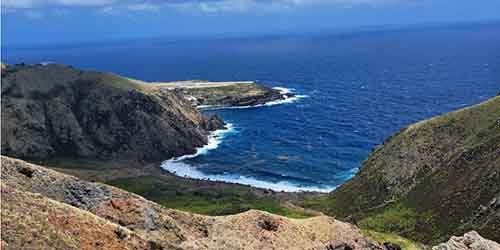The Public Entity Saba commissioned a comprehensive assessment of groundwater flow and nutrient dynamics on the island, examining how nitrogen and phosphorus are transported from land-based sources to the surrounding marine environment. This study provides critical insights for protecting coral reef ecosystems and guiding sustainable environmental management.

Background and Objectives
The study aims to understand how nutrients, particularly nitrogen (N) and phosphorus (P), are transported from land-based sources to the surrounding marine environment, with a focus on the role of groundwater. This knowledge is essential for protecting coral reef ecosystems and guiding sustainable environmental management.
Key Objectives
- Develop a first understanding of Saba’s hydrogeological system
- Identify and quantify nutrient sources and transport pathways
- Conduct a quick scan assessment of groundwater impacts on coastal water quality
Methodology
The research employed a multi-faceted approach combining:
- Literature review and field surveys
- Stakeholder interviews
- Water quality sampling and laboratory analysis
- Development of a conceptual groundwater model
Nutrient and water balances were calculated for individual catchments to estimate contributions from various sources, including domestic wastewater, livestock, tourism, agriculture, and atmospheric deposition.
Main Findings
Groundwater as a Nutrient Pathway
Groundwater represents a major pathway for nutrient transport to the sea, with elevated nitrate levels detected in wells and springs throughout the island.
Nutrient Sources
Currently, cesspits are the primary source of nutrients, followed by livestock and atmospheric deposition. The contribution hierarchy reflects the island’s settlement patterns and waste management infrastructure.
Subsurface Flow Routes
Two potential subsurface flow routes were hypothesized:
- Slow, permanent groundwater flow – Discharging year-round into the sea
- Quick interflow route – Activated during heavy rainfall events, contributing to erosion and nutrient pulses
Coastal Water Quality
Nutrient concentrations in coastal waters are elevated and approaching ecological thresholds for coral reef health, raising concerns about the long-term sustainability of the ecosystem.
Historical Impact of Livestock
Historical goat overpopulation (approximately 5,000 goats in 2020) significantly contributed to nutrient loads. Current population levels (~150 goats) have substantially reduced this impact, demonstrating the effectiveness of population control measures.
Conclusions
The study establishes several key conclusions about Saba’s nutrient dynamics:
- Dual flow system: Saba’s geology and steep terrain create a dual water flow system characterized by slow groundwater discharge and fast interflow during storms
- Primary nutrient carrier: Groundwater serves as the primary year-round carrier of nutrients to the sea, especially nitrate from cesspits
- Ecosystem risk: Nutrient levels in groundwater are high enough to pose a risk to coral reef ecosystems, even though total nutrient inputs are modest compared to larger islands
- Management success: The reduction in goat population has significantly decreased nutrient pressure, though human wastewater remains a key concern
Recommendations
Monitoring Enhancement
Improve monitoring of rainfall, groundwater, and runoff to reduce uncertainty in nutrient transport modeling and provide better data for management decisions.
Infrastructure and Land Management
Enhance rainwater infiltration and reduce surface runoff through improved land and road design, which will help mitigate nutrient pulses during storm events.
Ongoing Management Priorities
- Continue the goat control programme to maintain reduced nutrient loads from livestock
- Improve wastewater management in new developments when possible and economically viable, focusing on alternatives to traditional cesspit systems.
The full report is available HERE.
Deltares

 Saba News News and Information from Saba Island, Dutch Caribbean
Saba News News and Information from Saba Island, Dutch Caribbean
